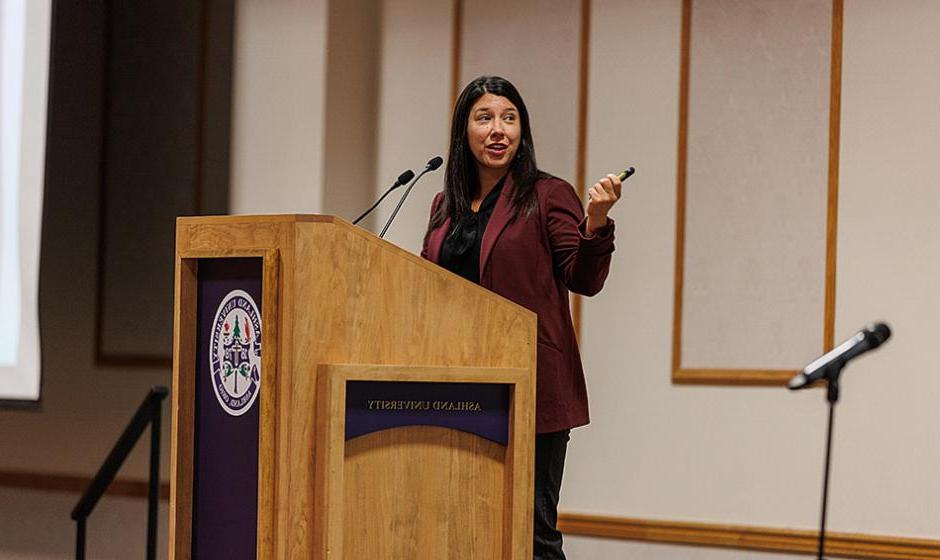
Forensic psychologist offers AU audience new ideas to consider to help eliminate mass shootings
Katelynn Roach’s reaction to years of school mass shooting drills maybe contributing to a student eventually doing it for real?
“I had never thought of that,” said the Ashland University criminal justice major.
Ian Zapcic’s reaction to softening measures being more effective than toughening procedures in stopping a mass shooter?
“That was what really jumped out at me,” said the visiting professor of social work at AU.
And Dennis Dyer’s reaction to human connection preventing a mass shooting?
“I found it very promising,” said the retired director of ACADA (Ashland County Council on Alcoholism and Drug Abuse).
While much of what speaker Jillian Peterson presented about mass shootings Tuesday, Oct. 10, in the Trustees Room of the Convocation Center affirmed what Roach, Zapcic and Dyer already knew or believed about the subject, several of Peterson’s statements were things the three really hadn’t considered before.
Carly George, clinical assistant professor of social work at AU, probably said it best when she closed out the first lecture of the 2023-24 Symposium Against Indifference: Perspectives on the Mental Health Crisis series by thanking Peterson: “You definitely gave us a lot of information to take home, to think about, to think about how we can apply it in our homes and in our places of work.”
Peterson, a forensic psychologist and associate professor of criminology at Hamline University in Minnesota, is the co-author of the book “The Violence Project: How to Stop a Mass Shooting Epidemic,” which is based on four years of in-depth research into the lives of mass shooters who not only opened fire in schools, but other public places such as colleges, businesses and places of worship.
“I really do feel hopeful,” Peterson told the good-sized crowd of AU students, faculty and staff, as well as community members early in her talk. “I felt like this is something we can do something about if we embrace the complexity, if we pull people together, if we pull people in rather than push out.
“It really did feel like there was reason to feel hope,” Peterson added about the completion of the book. “This is not something that is an inevitable piece of American life; it’s something we can prevent.”
As a social work professor, Zapcic said it was really exciting to hear about a new law that was recently passed in Minnesota softening the stance on active shooter drills that he didn’t know about until Peterson mentioned it during her presentation.
It bans using effects such as fake gunshots, blood or jiggling of doorknobs for active shooter simulations; students can opt out of the drills that have to be announced 24 hours in advance; and schools will be required to provide time for debriefing and mental health support.
Peterson said she believes students really don’t need to go through any kind of active drilling.
“We generally advocate for drilling for adults,” she said. “You do need to practice. You need to know what to do in case of any emergency. Every adult in the building needs to know what to do. What we see is what you need is really good communication in a crisis and systems relaying the information in a crisis, and students listening to their teachers.”
Having students trust adults in schools and feel safe to report anything out of the ordinary with classmates (possibly with anonymous reporting) are some other prevention strategies that Peterson said research shows can make a difference.
Beside the school drills sometimes planting the idea in a student’s mind of carrying out a mass shooting and having insider information about how to do it, Roach said she also didn’t think much about the effects active shooter drills have on students’ mental health until listening to Peterson.
“I remember I used to have drills where teachers would walk by and wiggle the doorknob and people announcing where the ‘perpetrator’ was, which was scary and weird,” said the AU junior.
The part of Peterson’s presentation that probably impacted her the most was when Peterson said they talked to some of the mass shooters who were still alive and asked them if anyone could have stopped them.
“And they said anyone could have,” Roach said.
That’s because the research shows most mass shooters were suicidal and were looking for human connections for help, according to Peterson.
“That hopelessness gives us a prevention point because we know a lot about suicide prevention,” Peterson said. “We don’t tend to apply it here.
“It really shifts your thinking,” Peterson added.
Not only did Dyer, who was involved in mental health as the ACADA director, find it promising that there may be some suicide prevention intervention spots where young people and adults can be reached to prevent mass shootings, Roach hopes to do some of that reaching out after graduating from AU.
“I want to work with juveniles and be a support system for them and be one person who tells them they are great,” the junior said. “That’s something I really believe in, so it was nice to see that backed up by data.”
The Violence Project challenges not only Roach, but everyone to do something to help solve the problem, said Craig Hovey, AU religion professor and director for the Ashland Center for Nonviolence, which sponsored the event with the Ashland County Mental Health and Recovery Board.
“But we first need to understand what’s going on,” Hovey also said to the crowd while introducing Peterson, “and not be afraid to discover that there are no easy answers. Dr. Peterson’s work is exceptional in this regard.”
For more information about The Violence Project, visit theviolenceproject.org.